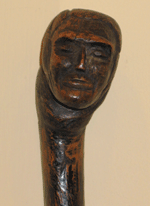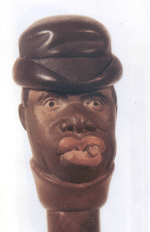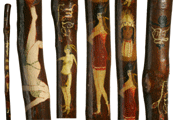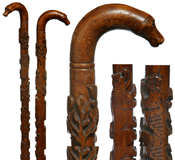|
Folk Art Canes
By Stuart White
I began collecting walking sticks in the early seventies, and like most
collectors, started modestly with little knowledge of their value. At the time,
there was very little reading material available. However, I had a fancy for
these pieces of history and began my own quest for knowledge. I learned that the
composition of canes varied from wood, cane, leather, ivory, bamboo and reed to
gutta-percha. I discovered canes made of shark vertebrae, cork and metal, as
well as other unusual materials.
Canes with hidden compartments-referred to
as gadget canes, some containing weapons, tools, and medical instruments,
whimsical, glass and even musical instruments - were sighted at antique shops
and shows. The carved ivory handles covered every subject: the animal kingdom,
human compositions, plain, fancy, Deco and Art Nouveau, Victorian and even
erotica.
In the early days as I searched for sticks, I mistakenly often
overlooked the folksy ones, purchasing instead the fancier types and system
canes, not appreciating that these true pieces of history were one-of-a-kind
masterpieces. Many of the folk sticks were carved freestyle on a porch in the
South in Mississippi, Kentucky and the Carolinas, while others were created by
master carvers in Pennsylvania, Ohio, Michigan and further west. Names like
Mike/Orion, Frankie Feathers, and of course, the "Schtockschnitzler" Simmons and
the Bally carvers began to appear frequently in cane literature.
When George
Myers published American Folk Art Canes in 1992 and exhibited at the American
Folk Museum in Manhattan, lines formed around the block to view these wonderful
pieces. I was blown away by the size and scope of his collection, and seeing the
canes up close made a huge difference in my appreciation of folk art in general,
and especially folk canes.
Today, I own several thousand canes and currently
have an exhibit at the Parrish Art Museum in Southampton, New York. The museum
devoted a room displaying a grouping from my collection.
Purchasing folk
canes for investment. I began tracking folk art prices in the early eighties and
specifically the prices of folk art canes. I believe that these canes when
carved with detail, with good provenance (i.e., a Mike/ Orion or
"Schtockschnitzler" Simmons), and those with historical significance have
outpaced the stock market as well as many other types of investments.
The
following are examples of some recent prices for canes:
· The Emancipation
Cane, $9,800 in 2004.
· Mike/Orion Cane, $10,500 in 2005.
·
Schtockschnitzler" Sim-mons, $2,500 in 2005.
The most exciting news for
collectors and investors is there are still bargains if you search through flea
markets, antique fairs, auctions and eBay. While experienced dealers are keeping
a keen eye out for fine carved canes, there are many folks who, having lost
their grandparents, rummage through their closets and find old sticks long
forgotten. Having little knowledge of their worth, the family offers them for
sale at very reasonable prices.
The key to a fine folk cane is in the
carving, choice of material, color, composition, etc. Age cracks, scuffs and
bruises are quite acceptable; even a missing nose or part of a tail is
acceptable and does not necessarily render the piece worthless. I find the more
desirable sticks are intricately carved all the way down and have a figure on
top. Of course, every once in a while you stumble across a beautifully carved
cane, carefully preserved and in mint condition. However, beware of knockoffs
and forgeries.
The photos shown depict great examples of rare folk canes.
Mike/Orion used mostly diamond willow as the preferred wood when he executed his
craft with the skill of a surgeon. Not much is known about him, except he lived
in Michigan near the village of Orion. George Myers in his book provides
examples of Mike/Orion sticks; Myers is the largest known collector of
Mike/Orion canes.
The emancipation cane carved, has many interesting
contradictions, including a dove where the hammer-lock would normally be. The
inscriptions read, "JAN 1 1883," Holy Bible", "USA", & "love". Canes like
these a decade ago could be purchased for under a thousand dollars. Now, they
are bringing more than $10,000 at auction. I predict that within five years, a
Mike/Orion cane will fetch $25,000, so mark it on your calendar.
There are
now many reference books and articles on American Folk Canes, the two main ones
being George Myers' and Catherine Dike's Canes In America.
Caution is always
prudent when starting a collection. Speak with experts, feel and touch the fine
folk canes until identifying them becomes second nature. Often, you will
overhear a dealer, auctioneer or expert comment, "It just doesn't feel right,"
meaning something about the piece is inconsistent with the subject, or the
material used is not consistent to the period. Instinct often overrules
logic.
In conclusion, only with experience will you become secure in your
purchases. My favorite quote is: "To the knowledgeable goes the bargain." Good
hunting!
|

"Winking Man" (one eye shut) carved cane, 19th c.


Erotica sells in
folk art canes, too.

Photo
Courtsey: Kimball Sterling Auctioneers |